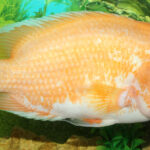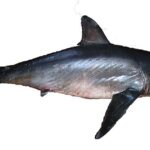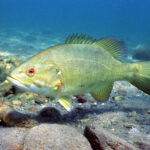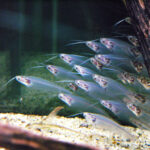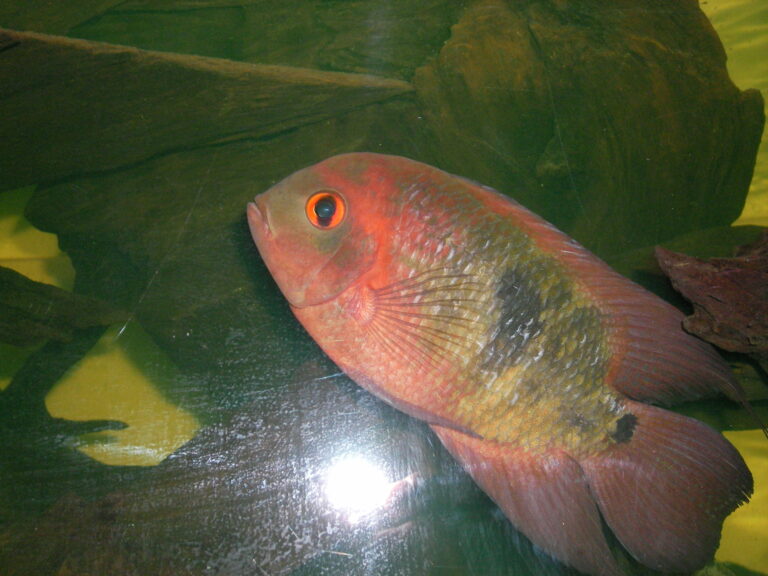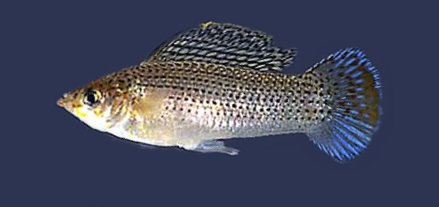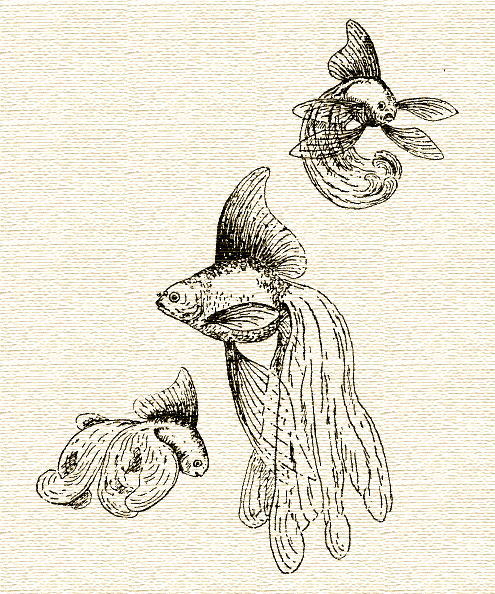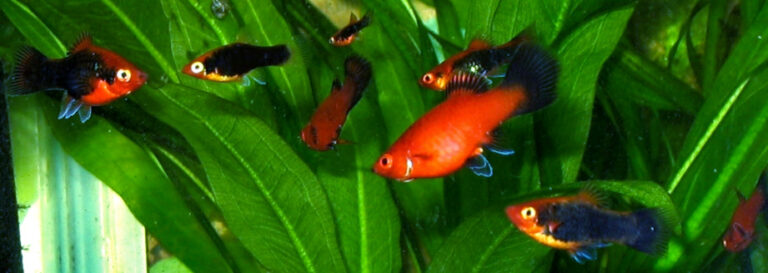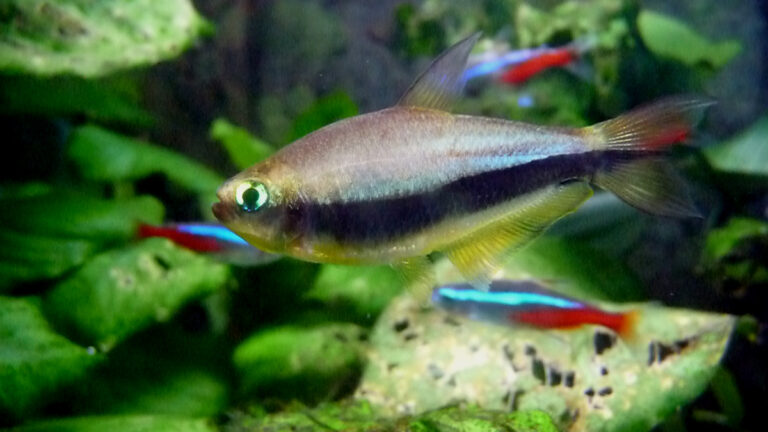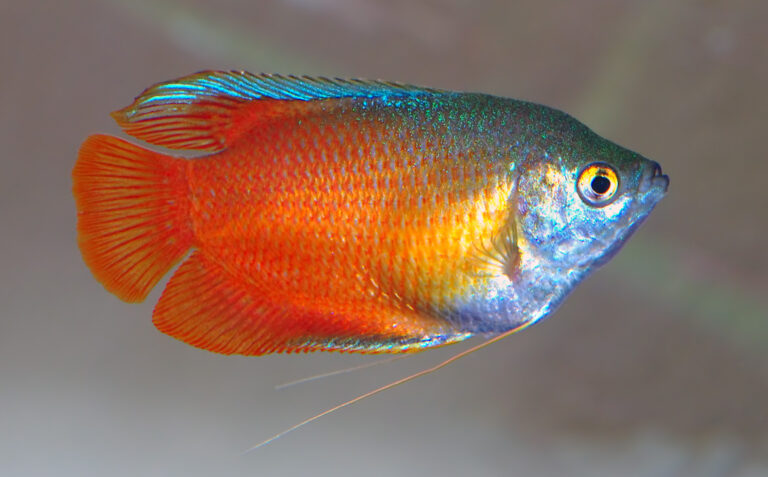Marble Molly
By Ryan Maron | Last Modified: June 14, 2025
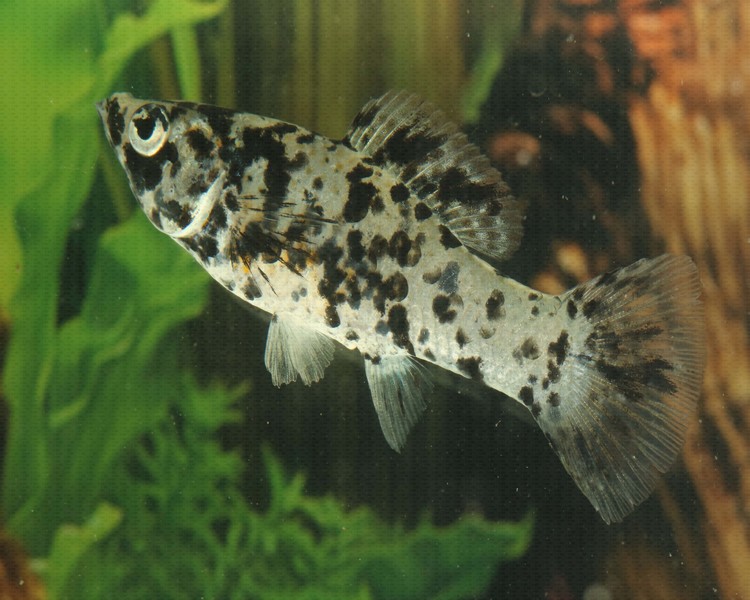
The Marble Molly (*Poecilia latipinna*) stands as one of the most recognizable and widely distributed ornamental fish species in the aquarium trade, distinguished by its striking marbled coloration pattern and remarkable adaptability to diverse aquatic environments. This livebearing freshwater fish, scientifically classified within the Poeciliidae family, represents a selectively bred variant of the sailfin molly, developed through decades of careful aquaculture practices to enhance its distinctive black and white mottled appearance.
Beyond its aesthetic appeal, the Marble Molly plays a significant ecological role as both a consumer of algae and small invertebrates and as a prey species for larger predatory fish in natural and semi-natural systems. Its tolerance for varying salinity levels and water conditions has made it an invaluable model organism for studying osmoregulation and environmental adaptation in teleost fish. The species demonstrates remarkable reproductive efficiency, contributing to population stability in established ecosystems while serving as an indicator species for water quality assessment in freshwater habitats.
The Marble Molly’s ecological importance extends beyond ornamental purposes, as wild populations contribute to nutrient cycling in shallow coastal waters and freshwater systems throughout their native range in the southeastern United States and parts of Mexico. Their feeding behavior helps control mosquito larvae populations, making them valuable allies in natural pest management systems.
| Feature | Details |
|---|---|
| Common Name | Marble Molly |
| Scientific Name | Poecilia latipinna |
| Family | Poeciliidae |
| Typical Size | 8-12 cm (3-5 inches), 15-25 grams |
| Habitat | Shallow freshwater and brackish environments |
| Diet | Omnivorous – algae, small invertebrates, detritus |
| Distribution | Southeastern United States, introduced worldwide |
| Conservation Status | Least Concern |
Taxonomy & Classification
The Marble Molly belongs to the order Cyprinodontiformes, a diverse group of small freshwater and brackish water fish characterized by their surface-dwelling habits and specialized feeding mechanisms. Within this order, the family Poeciliidae encompasses over 220 species of livebearing tooth-carps, making it one of the most successful freshwater fish families in terms of species diversity and geographic distribution.
The genus *Poecilia* was first established by Bloch and Schneider in 1801, with *Poecilia latipinna* formally described by Lesueur in 1821 based on specimens collected from New Orleans waters. The species name “latipinna” derives from Latin, meaning “broad fin,” referencing the characteristically enlarged dorsal fin of mature males. Modern molecular phylogenetic studies have confirmed the Marble Molly’s close relationship to other members of the *Poecilia* species complex, including the shortfin molly (*P. mexicana*) and the liberty molly (*P. salvatoris*).
Recent taxonomic revisions have recognized several subspecies of *P. latipinna* based on morphological and genetic variations across different geographic populations. The marble coloration pattern represents a recessive genetic trait that has been selectively enhanced through captive breeding programs, resulting in the distinctive phenotype observed in contemporary aquarium strains. This artificial selection has not altered the species’ fundamental taxonomic classification but has created morphologically distinct populations that retain full reproductive compatibility with wild-type individuals.
Cytogenetic analysis reveals a diploid chromosome number of 2n=46, consistent with other members of the Poeciliidae family, while karyotype studies have identified specific chromosomal markers associated with the marble coloration genes.
Physical Description
The Marble Molly exhibits pronounced sexual dimorphism, with mature males typically reaching 8-10 centimeters in standard length while females commonly grow to 10-12 centimeters. The species’ most distinctive feature is its irregular black and white marbled coloration pattern, created by the uneven distribution of melanophores and iridophores throughout the skin and scales. This mottled appearance varies significantly among individuals, with some specimens displaying bold, contrasting patches while others show more subtle gradations between light and dark pigmentation.
Male Marble Mollies develop an enlarged, sail-like dorsal fin that can extend up to 15-18 rays in mature specimens, compared to the more modest 12-14 rays typical of females. The gonopodium, a modified anal fin used for internal fertilization, represents another key male characteristic, measuring approximately 15-20% of the fish’s standard length and featuring a complex hook-and-claw structure for sperm transfer. The caudal fin displays a distinctive lyrate shape in both sexes, though males often exhibit more pronounced fin extensions and enhanced coloration intensity.
The body profile maintains the typical molly configuration with a moderately compressed, laterally flattened form and a slightly upturned mouth adapted for surface feeding. Scale counts consistently range from 26-30 along the lateral line, with 8-10 scales above and 7-9 scales below this reference line. The head comprises approximately 23-26% of the standard length, housing relatively large eyes positioned high on the skull for optimal detection of surface prey and aerial threats.
Mature specimens display subtle but important morphological adaptations for their semi-euryhaline lifestyle, including modified gill rakers for efficient osmoregulation and enlarged kidney structures capable of processing varying salt concentrations. These physiological features enable successful transitions between freshwater and low-salinity brackish environments.
Habitat & Distribution
The natural range of the Marble Molly encompasses the coastal plains and lowland waterways of the southeastern United States, extending from North Carolina south through Florida and west along the Gulf Coast to eastern Texas. Native populations demonstrate strong preferences for shallow, vegetated habitats including freshwater marshes, slow-moving streams, drainage ditches, and brackish coastal areas where salinity levels fluctuate with tidal influences and seasonal precipitation patterns.
Within their native range, Marble Mollies typically inhabit waters with temperatures ranging from 18-32°C, though they can tolerate brief exposures to both cooler and warmer extremes. The species shows remarkable adaptability to varying salinity conditions, successfully reproducing in environments ranging from pure freshwater (0 ppt) to moderately brackish conditions (15-18 ppt). This euryhaline capability stems from specialized chloride cells in the gills and sophisticated kidney function that allows efficient regulation of internal osmotic balance.
Preferred microhabitats include areas with abundant emergent and submerged vegetation, particularly zones dominated by *Vallisneria*, *Sagittaria*, and various *Potamogeton* species that provide both food resources and protective cover. Water depth preferences typically range from 0.3-2.0 meters, with gravid females often seeking even shallower areas among dense plant growth for parturition. The species demonstrates strong site fidelity, with established populations maintaining consistent territory boundaries across multiple generations.
Human introduction has dramatically expanded the Marble Molly’s global distribution, with established populations now documented across temperate and subtropical regions worldwide. These introduced populations have shown particular success in areas with similar climate conditions to their native range, including parts of Australia, southern Europe, and various Pacific islands. However, their invasive potential in sensitive ecosystems has raised conservation concerns in several regions where they compete with native fish species for limited resources.
Diet & Feeding Behavior
The Marble Molly exhibits omnivorous feeding behavior with a pronounced preference for algae and other plant materials, classifying it as a primarily herbivorous species within the freshwater fish community. Stomach content analysis reveals that algae typically comprises 60-70% of the natural diet, with filamentous green algae, diatoms, and blue-green algae representing the most commonly consumed plant matter. The species demonstrates particular efficiency in grazing periphyton from submerged surfaces, using specialized pharyngeal teeth to scrape and process tough algal materials.
Animal protein sources constitute approximately 25-30% of the natural diet, with small invertebrates including chironomid larvae, copepods, ostracods, and various aquatic worms providing essential amino acids and fatty acids for growth and reproduction. Juvenile Marble Mollies consume proportionally more animal protein than adults, with invertebrate prey comprising up to 45% of their diet during the first three months of life when rapid growth demands high-quality protein sources.
The species exhibits distinct feeding periodicity, with peak foraging activity occurring during dawn and dusk hours when many invertebrate prey species are most active near the water surface. This crepuscular feeding pattern aligns with the fish’s natural predator avoidance strategies while maximizing encounter rates with preferred food items. Surface feeding behavior becomes particularly pronounced during warm weather periods when terrestrial insects frequently fall onto the water surface.
Seasonal dietary variations reflect changing food availability throughout the year, with increased consumption of mosquito larvae during warmer months contributing to the species’ reputation as an effective biological control agent. During cooler periods, the diet shifts toward more readily available detrital materials and decomposing plant matter, demonstrating the species’ adaptive feeding flexibility. This dietary versatility contributes significantly to the Marble Molly’s success in diverse aquatic environments and explains its effectiveness as an introduced species in many global locations.
Behavior & Adaptations
Marble Mollies display complex social behaviors characterized by loose schooling tendencies and hierarchical dominance structures that vary with population density and environmental conditions. In natural settings, groups typically consist of 8-15 individuals with a roughly equal sex ratio, though temporary aggregations of 30-50 fish may form in areas with concentrated food resources or optimal spawning conditions. The species demonstrates moderate territorial behavior, particularly among mature males during breeding periods when competition for access to receptive females intensifies.
Swimming patterns reflect the species’ surface-oriented feeding ecology, with individuals spending 70-80% of their active time in the upper third of the water column. This behavior facilitates efficient capture of surface prey while maintaining proximity to atmospheric oxygen sources during periods of aquatic hypoxia. The species exhibits remarkable jumping ability, capable of clearing obstacles up to 8-10 centimeters in height when escaping predation threats or navigating shallow areas with limited swimming space.
Thermoregulatory adaptations enable successful function across a broad temperature range, with behavioral modifications including depth selection and microhabitat preferences helping maintain optimal body temperatures. During extreme temperature events, Marble Mollies demonstrate remarkable physiological resilience, temporarily reducing metabolic rates and seeking thermal refugia in deeper waters or areas with consistent thermal inputs from groundwater sources.
The species’ osmoregulatory capabilities represent one of its most significant evolutionary adaptations, enabling transitions between freshwater and brackish environments that would prove fatal to many other freshwater fish species. Specialized chloride cells in the gill epithelium actively transport excess sodium and chloride ions from the bloodstream, while modified kidney function concentrates urine to minimize water loss in higher salinity conditions. These adaptations allow successful colonization of estuarine habitats and explain the species’ tolerance for the varying water conditions common in molly fish environments.
Communication behaviors include subtle color changes, fin positioning signals, and low-frequency sound production during courtship interactions, though these acoustic displays remain poorly studied compared to visual communication modes.
Reproduction & Life Cycle
The Marble Molly employs internal fertilization and viviparity, producing live young after a gestation period of approximately 28-35 days depending on water temperature and female nutritional status. Sexual maturity occurs at 3-4 months of age when individuals reach approximately 4-5 centimeters in length, though optimal reproductive performance typically develops over the subsequent 2-3 months as gonads fully mature and behavioral repertoires stabilize.
Courtship behavior involves elaborate displays by males featuring extended dorsal fin presentations, lateral body displays, and persistent following of receptive females. The gonopodium enables precise sperm transfer during brief mating encounters that typically last 2-3 seconds. Females possess the remarkable ability to store viable sperm for extended periods, enabling production of multiple broods from a single mating event over several months.
Brood sizes vary considerably with female age and size, ranging from 15-25 fry in young females to 40-80 offspring in mature specimens exceeding 10 centimeters in length. Gestation involves sophisticated maternal provisioning, with developing embryos receiving nutrients through specialized follicular structures that function similarly to placental connections in mammals. This advanced reproductive strategy provides distinct advantages over egg-laying species by protecting developing young from environmental hazards and predation during vulnerable early stages.
Parturition typically occurs in shallow, heavily vegetated areas that provide immediate shelter for newly released fry. Young Marble Mollies measure 6-8 millimeters at birth and possess fully developed swimming abilities, enabling immediate dispersal and feeding initiation. Growth rates average 0.8-1.2 millimeters per week during optimal conditions, with sexual differentiation becoming apparent after 6-8 weeks as males begin developing gonopodial modifications.
The species demonstrates remarkable reproductive resilience, with healthy females capable of producing 6-8 broods annually under favorable conditions. This high reproductive output contributes significantly to population stability and explains the species’ success as both a native and introduced fish in diverse aquatic systems worldwide. Environmental factors including temperature, photoperiod, and food availability strongly influence reproductive timing and success rates.
Predators & Threats
Adult Marble Mollies face predation pressure from various piscivorous species throughout their natural range, with largemouth bass (*Micropterus salmoides*), chain pickerel (*Esox niger*), and various sunfish species representing primary predators in freshwater systems. In brackish environments, additional threats include juvenile tarpon (*Megalops atlanticus*), snook (*Centropomus undecimalis*), and various gar species that exploit the mollies’ surface-dwelling habits. Avian predators such as herons, egrets, and kingfishers pose significant threats, particularly in shallow habitats where the fish’s distinctive coloration may actually increase visibility to aerial hunters.
Juvenile and subadult Marble Mollies experience substantially higher predation rates, with mortality estimates reaching 85-90% during the first six months of life. Predators targeting smaller size classes include dragonfly nymphs, diving beetles, water bugs, and various fish species that adults successfully avoid through size-based refuge. The species’ reproductive strategy of producing large numbers of offspring partially compensates for these high juvenile mortality rates.
Habitat degradation represents the most significant anthropogenic threat to wild populations, with urban development, agricultural runoff, and wetland drainage eliminating critical spawning and nursery areas throughout much of the species’ native range. Water quality deterioration from pesticide applications, fertilizer runoff, and industrial discharge particularly affects shallow habitats preferred by Marble Mollies, often reducing reproductive success and survival rates in impacted areas.
Climate change poses emerging threats through altered precipitation patterns, increased storm intensity, and shifting temperature regimes that may disrupt breeding cycles and habitat availability. Sea level rise threatens low-lying freshwater habitats along coastal areas, potentially forcing populations into suboptimal environments with reduced carrying capacity and increased competition with other species.
Invasive species interactions create complex ecological pressures, with introduced predators and competitors potentially displacing native Marble Molly populations from traditional habitats. Conversely, in regions where Marble Mollies themselves represent introduced species, they may face novel predation pressures from native fish communities while simultaneously impacting indigenous species through resource competition and habitat modification.
Conservation Status
The International Union for Conservation of Nature (IUCN) currently classifies the Marble Molly as “Least Concern” based on its widespread distribution, stable population trends, and remarkable adaptability to diverse environmental conditions. This classification reflects the species’ natural resilience and successful establishment in numerous regions beyond its native range, though local population declines have been documented in some areas experiencing intensive habitat modification.
Regional conservation assessments reveal more nuanced status variations, with several southeastern United States populations experiencing moderate pressure from urban development and agricultural intensification. The Florida Fish and Wildlife Conservation Commission monitors Marble Molly populations as part of broader freshwater fish community assessments, noting particular concern for populations in rapidly developing coastal areas where habitat fragmentation may limit gene flow between local populations.
Population genetics studies indicate healthy genetic diversity within most native populations, though some isolated populations in modified landscapes show evidence of reduced heterozygosity and potential inbreeding effects. These findings suggest that maintaining habitat connectivity represents a critical conservation priority for ensuring long-term population viability, particularly in fragmented landscapes where small, isolated populations may be vulnerable to local extinction events.
The species’ role as a biological control agent for mosquito larvae has generated interest from public health agencies, leading to intentional introductions in some regions for disease vector management. However, these programs require careful environmental assessment to prevent negative impacts on native fish communities and aquatic ecosystems. The balance between potential public health benefits and ecological risks continues to inform management decisions regarding Marble Molly introductions.
Conservation efforts for native populations focus primarily on habitat protection and restoration, with particular emphasis on preserving shallow wetland areas and maintaining natural hydrological patterns that support successful reproduction and recruitment. Water quality monitoring programs increasingly include Marble Mollies as indicator species for ecosystem health assessment in southeastern coastal watersheds.
Human Interaction
The Marble Molly’s relationship with human activities spans multiple sectors, from ornamental aquaculture to ecological management and scientific research applications. The global aquarium trade represents the species’ most visible human interaction, with millions of individuals bred annually in commercial facilities worldwide to supply hobbyist demand for attractive, hardy freshwater fish. Selective breeding programs have produced numerous color variants and fin modifications, though the classic marble pattern remains among the most popular choices for both novice and experienced aquarists.
Commercial aquaculture operations have developed sophisticated breeding protocols that optimize reproduction rates, juvenile survival, and adult coloration quality. These facilities typically maintain controlled environments with precise temperature regulation, specialized diets, and selective breeding programs that enhance desirable traits while maintaining genetic diversity. The economic value of Marble Molly production contributes significantly to rural economies in several regions, providing employment opportunities and supporting ancillary industries including feed production, equipment manufacturing, and distribution networks.
Scientific research applications utilize Marble Mollies as model organisms for studies investigating osmoregulation, reproductive biology, environmental toxicology, and evolutionary ecology. Their tolerance for varying experimental conditions, short generation times, and well-characterized biology make them valuable subjects for controlled laboratory studies. Research findings contribute to broader understanding of fish physiology and evolution while informing conservation strategies for related species.
Educational programs frequently feature Marble Mollies in classroom aquaria and nature center displays, where their active behavior and distinctive appearance help engage students in learning about aquatic ecosystems and fish biology. These educational applications promote scientific literacy and environmental awareness while providing hands-on experience with living organisms. Similar aquarium fish species serve comparable educational roles in schools and public facilities worldwide.
Biological control programs have employed Marble Mollies for mosquito larvae management in specific situations, though these applications require careful evaluation of potential ecological impacts. The species’ effectiveness in consuming mosquito larvae, combined with its ability to survive in artificial water bodies, makes it attractive for integrated pest management approaches in appropriate contexts.
Interesting Facts
The Marble Molly possesses several remarkable physiological and behavioral characteristics that distinguish it from other freshwater fish species. One of the most fascinating aspects of their biology involves their ability to survive in pure saltwater for short periods, a capability shared by very few freshwater fish species. Research has documented successful survival in full-strength seawater (35 ppt salinity) for up to 72 hours, though extended exposure eventually proves fatal due to osmotic stress and kidney function limitations.
Temperature tolerance studies have revealed extraordinary resilience to thermal extremes, with documented survival at temperatures as low as 8°C and as high as 38°C under controlled laboratory conditions. This thermal flexibility exceeds that of most temperate freshwater fish species and contributes significantly to the Marble Molly’s success as an introduced species in diverse climate zones. However, optimal performance occurs within the narrower range of 22-28°C where feeding, growth, and reproduction proceed most efficiently.
The species demonstrates remarkable longevity for a small freshwater fish, with properly maintained aquarium specimens occasionally reaching 4-5 years of age. Wild populations typically experience shorter lifespans due to predation pressure and environmental stresses, though individuals exceeding 3 years have been documented in stable natural habitats. This extended lifespan enables multiple reproductive seasons and contributes to population stability in established colonies.
Behavioral studies have revealed sophisticated learning capabilities, including the ability to recognize individual conspecifics, remember feeding locations, and modify behavior based on predation threats. Laboratory experiments demonstrate that Marble Mollies can learn to navigate simple mazes and respond to visual cues, suggesting cognitive abilities comparable to those of much larger fish species. These behavioral adaptations likely contribute to their success in novel environments following introduction.
The marble coloration pattern results from complex genetic interactions involving multiple loci that control melanophore distribution and activity. Interestingly, environmental factors including diet, water chemistry, and social stress can influence the expression of these color genes, leading to subtle variations in pattern intensity and distribution throughout an individual’s lifetime. This phenotypic plasticity represents an additional layer of adaptation that enhances survival prospects across varying environmental conditions.
Recent molecular studies have identified unique genetic markers associated with salinity tolerance in Marble Molly populations, suggesting that different populations may have evolved distinct physiological capabilities based on their local environmental conditions.
Frequently Asked Questions
Can Marble Mollies survive in saltwater aquariums?
While Marble Mollies possess remarkable salinity tolerance compared to most freshwater fish, they cannot survive indefinitely in full marine aquarium conditions. They can tolerate brackish water with salinity levels up to 15-18 parts per thousand and can survive brief exposures to higher concentrations, but extended periods in full saltwater (35 ppt) will eventually prove fatal. For optimal health and longevity, maintain them in freshwater or low-salinity brackish conditions with gradual acclimatization if salinity changes are necessary.
How can you distinguish male and female Marble Mollies?
Sexual dimorphism in Marble Mollies becomes apparent at 3-4 months of age through several distinctive characteristics. Males develop a modified anal fin called a gonopodium, which appears pointed and rod-like compared to the fan-shaped anal fin of females. Males also display enlarged, sail-like dorsal fins and typically maintain more intense coloration patterns. Females grow larger overall, develop rounded abdomens when gravid, and possess the traditional triangular anal fin structure common to most fish species.
What water conditions do Marble Mollies require for optimal health?
Marble Mollies thrive in water temperatures between 22-28°C with a pH range of 7.0-8.5, reflecting their natural preference for neutral to slightly alkaline conditions. They demonstrate exceptional tolerance for varying water hardness levels but perform best in moderately hard water with 150-300 ppm dissolved minerals. Regular water changes, adequate filtration, and stable environmental conditions promote optimal health, reproduction, and coloration intensity.
How often do Marble Mollies reproduce and how many offspring do they produce?
Female Marble Mollies can produce new broods every 4-6 weeks under optimal conditions, with 6-8 reproductive cycles possible annually. Brood sizes vary significantly with female age and size, ranging from 15-25 fry in young females to 40-80 offspring in mature specimens. The ability to store sperm enables females to produce multiple broods from a single mating, making them highly prolific reproducers capable of rapidly establishing new populations.
Conclusion
The Marble Molly represents a remarkable example of evolutionary adaptability and ecological resilience, successfully thriving across diverse aquatic environments while maintaining stable populations throughout its native range and beyond. Its unique combination of attractive coloration, hardy constitution, and fascinating reproductive biology continues to make it valuable both as an ornamental species and as a subject for scientific research. The species’ role in mosquito control and its contribution to aquatic ecosystem balance underscore its ecological importance beyond aesthetic considerations, ensuring its continued significance in both natural and managed aquatic systems worldwide.
Share The Article:
More Fish Species:
-
Chocolate Cichlid
The Chocolate Cichlid stands as one of South America’s most distinctive freshwater species, captivating aquarists and researchers alike with…
-
Betta Fish
The Betta Fish, scientifically known as Betta splendens, is one of the most visually captivating and widely recognized freshwater…
-
Green Terror Cichlid
The Green Terror Cichlid stands as one of South America’s most formidable and visually striking freshwater fish species, commanding…
-
Delta Tail Betta
The Delta Tail Betta (Betta splendens) represents one of the most recognizable and sought-after varieties within the aquarium trade,…
-
Black Molly
The Black Molly represents one of the most recognizable and enduring species in the freshwater aquarium trade, captivating both…
-
Veiltail Goldfish
The Veiltail Goldfish stands as one of the most distinctive and graceful varieties within the goldfish family, renowned for…
Discover
-
Michigan Fishing License 2025: Complete Cost & Requirements Guide
Ask any angler about the most frustrating part of fishing, and paperwork will likely rank right up there with…
-
Utah Fishing License Guide: Costs, Requirements & Hidden Tips for 2025
When I first planned a fishing trip to Utah’s beautiful waters about a decade ago, figuring out the licensing…
-
Best Fishing Line for Bass in 2025: What Actually Works
I still remember the day I lost that monster largemouth on Lake St. Clair back in 2019. The fish…
-
History of Fly Fishing: Ancient Origins to Modern Mastery
The gentle art of fly fishing has captivated anglers for centuries, evolving from a practical method of obtaining food…
-
Why Stoner Fish Catch is Different: Unusual Angling Tactics
Let’s face it – some fish just act plain weird. Whether you’re an experienced angler or just starting out,…
-
Great White Shark
The Great White Shark (*Carcharodon carcharias*) stands as one of the ocean’s most formidable apex predators, commanding respect and…
Discover
-
Wagtail Platy
The Wagtail Platy stands as one of the most distinctive and beloved freshwater aquarium fish, renowned for its elegant…
-
Louisiana Redfish Fishing: Best Spots & Tactics for Beginners
Finding that first bull red is a moment you never forget. The pull, the power – it’s something special….
-
Emperor Tetra
The Emperor Tetra (*Nematobrycon palmeri*) stands as one of the most distinctive and sought-after freshwater fish species in the…
-
How to Use a Spinnerbait: Complete Guide for Beginners
In my three decades of fishing experience, I’ve found few lures as versatile and effective as the humble spinnerbait….
-
Honey Gourami
The Honey Gourami (*Trichogaster chuna*) stands as one of the most captivating freshwater fish species in the aquarium trade,…
-
Yellowfin VS Bluefin Tuna: Which Should You Target? (Expert Guide)
Let’s be honest – the first time I saw a yellowfin and bluefin tuna side by side at the…


